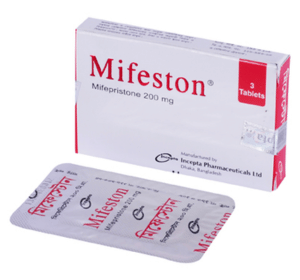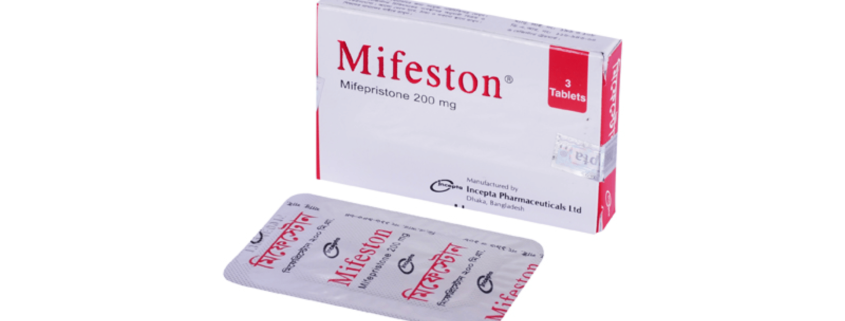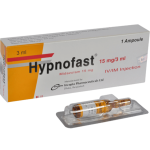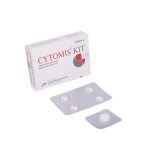Mifeston(Mifepristone)
Therapeutic Group: Gynaecological

Presentation
Mifeston: Each Tablet contains Mifepristone 200 mg
Description
Mifepristone is an antiprogestin; that is, it blocks the action of progesterone, a naturally produced hormone that prepares the inner lining of the uterus for implantation of a fertilized ovum and support of a growing embryo and placenta. The drug is taken orally in a prescribed dose during the first seven to nine weeks of pregnancy, and within two days the uterine lining begins to deteriorate, usually causing bleeding similar to that experienced during normal menstruation. The Mifepristone is then followed up by a dose (taken orally or as a vaginal suppository) of the synthetic prostaglandin Misoprostol, which stimulates the uterus to undergo contractions. The embryo and other uterine contents are expelled in a process very similar to spontaneous abortion or miscarriage.
Indications
1. As a medical alternative to surgical termination of intra-uterine pregnancy
2. Softening and dilatation of the cervix uteri prior to surgical pregnancy termination
3. Preparation for the action of prostaglandin analogues in the termination of pregnancy for medical reasons
4. Labour induction for the expulsion of a dead fetus (fetal death in utero).
Dosage & Administration
There are no precautions for timing in relation to food.
1. As a medical alternative to surgical termination of intra-uterine pregnancy in early pregnancy: 600 mg Mifepristone (3 tablets) in a single oral dose followed 36-48 hrs later, by the administration of a prostaglandin analogue Misoprostol 400 mcg orally (up to 49 days) or Gemeprost 1 mg vaginally (up to 63 days).
2. Softening and dilatation of the cervix uteri prior to surgical pregnancy termination: 200 mg Mifepristone (one tablet), followed 36-48 hrs later (but not beyond) by a surgical termination of pregnancy.
3. Preparation for the action of prostaglandin analogues in the termination of pregnancy for medical reasons (to reduce the doses of prostaglandin): 600 mg of Mifepristone (3 tablets) taken in a single oral dose, 36-48 hrs prior to scheduled prostaglandin administration which will be repeated as often as indicated.
4. Labour induction for expulsion of a dead fetus (fetal death in utero): 600 mg of Mifepristone in a single oral daily dose for 2 consecutive days. Mifepristone alone leads to expulsion in about 60%. Labour should be induced by the usual methods if it has not started within 72 hrs following the first administration of Mifepristone.
Side Effects
It is very common for women to experience uterine contractions or cramping (10-45%) in the hours following prostaglandin intake. Bleeding increases with gestational age. Heavy bleeding occurs in about 5% of cases and from 0-1.4% may require haemostatic curettage. Uterine rupture, hypotension, skin rashes, urticaria, hot flashes and dizziness have been uncommonly reported.
Precautions
Mifepristone is available only in single dose packaging. Administration must be under the supervision of a qualified physician.
There are no data on the safety and efficacy of Mifepristone in women with chronic medical conditions such as cardiovascular, hypertensive, hepatic, respiratory or renal disease; insulin-dependent diabetes mellitus; severe anemia or heavy smoking. Women who are more than 35 years of age and who also smoke 10 or more cigarettes per day should be treated with caution because such patients were generally excluded from clinical trials of Mifepristone.
Although there is no clinical evidence, the effectiveness of Mifepristone may be lower if Misoprostol is administered more than two days after Mifepristone administration.
Use in Pregnancy & Lactation
Pregnancy: Mifepristone is indicated for use in the termination of pregnancy (through 49 days’ pregnancy) and has no other approved indication for use during pregnancy.
Lactation: It is not known whether Mifepristone is excreted in human milk. Many hormones with a similar chemical structure, however, are excreted in breast milk. Since the effects of Mifepristone on infants are unknown, breast-feeding women should consult with their health care provider to decide if they should discard their breast milk for a few days following administration of the medications.
Use in children
Safety and effectiveness in pediatric patients have not been established.
Drug Interaction
ketoconazole, itraconazole, erythromycin and grapefruit juice may inhibit its metabolism (increasing serum levels of mifepristone). Furthermore, rifampicin, dexamethasone, St John\’s Wort and certain anticonvulsants (phenytoin, phenobarbital, carbamazepine) may induce mifepristone metabolism (lowering serum levels of Mifepristone).
Based on invitro inhibition information, co-administration of mifepristone may lead to an increase in serum levels of drugs that are CYP3A4 substrates.
Limited evidence suggests that co-administration of NSAIDs on the day of prostaglandin administration does not adversely influence the effects of Mifepristone or the prostaglandin on cervical ripening or uterine contractility and does not reduce the clinical efficacy of medical termination of pregnancy.
Over Dose
Single doses of Mifepristone up to 2G caused no unwanted reaction. In the event of massive ingestion, signs of adrenal failure might occur. Acute intoxication may require admission to hospital and if relevant treatment with dexamethasone.
Commercial Pack
Mifeston 200: Each box contains 1 Alu-Alu blister strips of 3 tablets.



